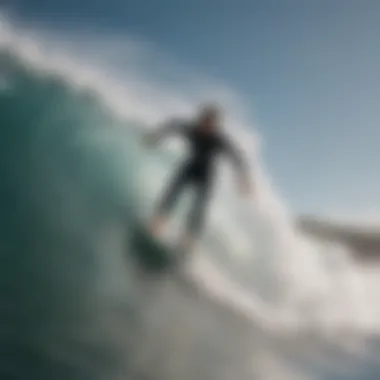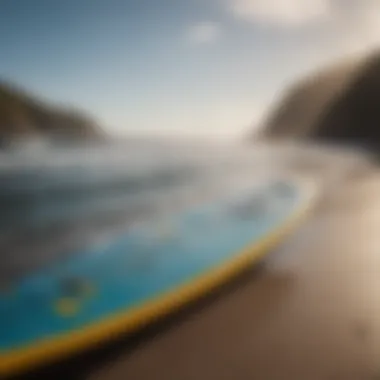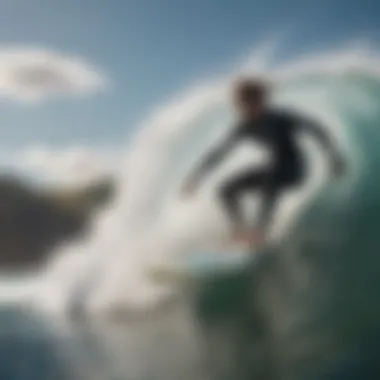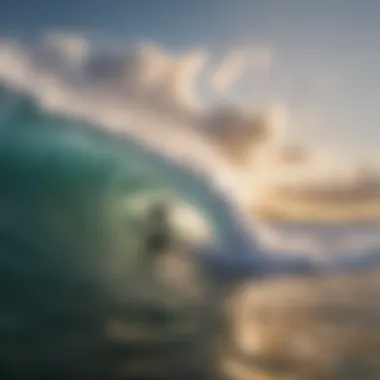Navigating Wind Patterns: Essential Insights for Surfers


Intro
Understanding the wind is crucial for every surfboarding enthusiast. It significantly influences wave conditions, making the difference between a good surfing day and a bad one. Every surfer needs to be aware of wind patterns, including direction and strength, to improve their overall surf experience.
In this analysis, we will delve into the techniques of surfboarding. This will cover various maneuvers that can enhance performance and adaptability based on changing wind conditions. We will also discuss how maintenance of surfboards can affect a surfer's performance and how to optimize their gear for better outcomes. Additionally, we will explore a range of surfing destinations and travel tips to ensure that surfers can make informed decisions on where to ride waves. Lastly, we will highlight surfboard equipment necessities and innovations that have emerged in recent years to improve the surfing experience.
This guide is intended for all skill levels. From novice, who might just learn to paddle out, to seasoned surfers looking to refine their skills and knowledge. Adapting to wind conditions is an art and science that enhances one's ability to enjoy surfing experiences.
Surfboarding Techniques
Types of Waves
Waves are categorized based on their formations, each providing different experiences for surfers. The primary types include:
- Beach Breaks: Commonly form on sandy bottoms and vary daily, offering diverse kickers and styles
- Reef Breaks: More consistent but demanding, typically positioned on rocky islands
- Point Breaks: Waves that peel around a point, creating long ride and well-defined lines
Understanding these wave types is essential. The surfboard’s control varies with each type, and wind plays a pivotal role.
Pop up Technique
The pop-up is a fundamental skill. Surfing enthusiasts must rely on a correct technique to rise on the board effectively. Steps include:
- Find Balance: Practice on stable ground to feel the motion of standing.
- Quick Movement: Transfer your weight from your chest to your feet in a fluid motion.
- Positioning: Feet should land near the tail while maintaining knees bent for balance.
Success ensures you can greet waves with confidence regardless of wind conditions.
Bottom Turn Maneuver
Once you’re standing, making the bottom turn becomes vital. This move helps set the tone for subsequent maneuvers. Important aspects to consider include:
- Timing: Execute just before reaching the wave’s critical section
- Weight Distribution: Shift weight toward your back foot when turning
Improved bottom turns can harmonize with wind intensity, creating a smoother ride.
Duck Diving
Duck diving helps surfers navigate through waves while paddling out. Key practices involve:
- Arm Positioning: Place your hands on the board’s rails and push down as you dive under a wave
- Timing: Engage before the impact of the wave carries it towards you
Learning this technique will enhance your out 😌experience.
Cutback
The cutback lets surfers return towards the breaking section of the wave. To ensure a smooth cutback, focus on:
- Pulling back
- Maximizing speed
- Hip movements
As crucial as handling skils, can grow depth in wind directions.
Understanding Wind Dynamics in Surfboarding
Understanding wind dynamics is fundamdental for anyone looking to enhance their surfboarding experience. Wind plays a significant role in shaping the ocean waves surfers depend on. Recognizing these dynamics allows surfers to make educated decisions on when and where to ride. It's not just about feeling the breeze; it's about understanding its impact on the surf environment.
The Basics of Wind Formation


Wind formation is rooted in atmospheric conditions. It arises due to differnces in air pressure caused by uneven heating of Earth's surface. Areas with high pressure generate winds that move toward regions of low pressure. This movement is critical, influencing how waves are created and how they travel across the ocean.
Surfers need to be aware that local city topography and temperature variations can significantly affect wind patterns on a smaller scale. Understanding these fundamentals allows them to predict surf conditions more accurately and select the right spot to catch waves.
Types of Wind Patterns
Different wind patterns affect surf conditions in unique ways. It is vital for surfers to have knowledge of these variations. Different types of wind patterns that arise form a mix of local and global influences shape various surfing conditions.
Local vs.
Global Winds
Local winds arise due to immediate geographical features while global winds originate from larger scale atmospheric systems. Local winds, such as land-seabreezes, have a direct impact on short-range surf effects. They can modify wave height and direction close to the shore. Global winds, on the other hand, tend to have a stage influence on surf quality, creating larger swells that travel great distances. Understanding these factors help surfers make strategic choices about their surfing times and spots.
One key characteristic of local winds is their variability. Surfers can feel sudden changes that can affect conditions instantly. Global winds provide consistency, allowing prediction of swells days in advance.
Seasonal Wind Changes
Seasonal wind changes are an important aspect to consider. As the seasons rotate,, so do wind currents. These shifts have a direct impact on wave patterns. For instance, during winters in temperate climates, north or west winds might produce significant waves. Conversely, summer patterns often result inft lighter winds, which may reduce wave intensity.
By examining historical data on these changes, surfers can maximize their time in the water. Planning becomes easier with an awareness of seasonal trends.
Predominant Wind Directions
Wind direction influences not just wave formation but the overall characteristics of the surf. Predominant wind directions change by region and season, determining which surf breaks will be ideal. In many cases, offshore winds contribute to cleaner waves, while onshore winds can create choppy conditions. This connection between wind direction and wave quality can dictate the amount of enjoyable time for surfers as well as the types of those waves. Every surfer should familiarize themselves with the typical wind directions in their area.
The Influence of Wind on Ocean Waves
Understanding how wind affects ocean waves is crucial for surfers. Winds play a significant role in generating and shaping waves, which are the foundation of a good surf. Knowing the relation of wind to waves allows surfers to predict surf conditions better and ultimately decide when to hit the water for the best experience.
Wind Speed and Wave Height
Wind speed directly influences wave height. As the wind blows over the water, it creates friction between the air and the water's surface. The stronger the wind, the higher the waves tend to be.
There are a few important factors involved here:
- Duration: The length of time the wind blows over the surface contributes significantly to wave growth. Consistent winds for extended periods result in bigger and more powerful waves.
- Area: The larger the area over which the wind blows, known as fetch, the more energy these waves can gather. On vast oceans, this results in meaty waves that thrill surfers.
- Speed: Higher winds increase wave energy but also can lead to chaotic wave behaviors. When the wind speed reaches a certain level, more experienced surfers find the best waves yet novices may struggle with control.
Understanding these elements helps a surfer to gauge when exactly a day might offer thick, high waves or when the speed is too much.
Wind Direction and Wave Shape
The direction from which the wind blows profoundly influences wave shape. This has practical implications for surfers when planning their surf sessions.
- Onshore Winds: When winds blow directly towards the shore, the waves tend to lose their shape. They become choppy and less predictable. This scenario often occurs in the morning or evening when the atmosphere cools.
- Offshore Winds: However, strong offshore winds, which blow from land to sea, help groom waves, making them cleaner and offering a more enjoyable ride. These winds allow waves to hold their shape longer, resulting in desirable surf conditions.
- Side Shore Winds: Winds that blow parallel to the coastline create waves that can be fun with moderate shape but might tweak their performance unpredictively. Surfers often adapt their riding style according to how these waves break.
Understanding the important aspects of wind direction can enhance a surfer's decision-making on whether conditions at their desired break are indeed worth heading out for.
Fetch: The Journey of Waves
Fetch is a term referring to the distance wind travels across open water, which greatly influences wave development.
- Long Fetch: A long fetch allows waves to build energy and height strongly and uniformly, resulting in ideal conditions for surfers. Regions with extensive fetch are often marked by consistent wave swells.
- Short Fetch: Alternately, short fetch means that waves don't have enough time or distance to build properly. These waves typically lack the energy needed to really carry a surfer.
This concept makes it apparent that geographical features can create, block or alter fetch, establishing essential conditions along coastlines worldwide. Knowledge of fetch is vital for informed surf planning.


Understanding Wind Reports and Forecasts
Understanding wind reports and forecasts is vital for surfing enthusiasts. Wind not only impacts wave quality, but it also affects safety and overall conditions at the beach. Knowledge of upcoming wind patterns allows surfers to choose the right times and locations for optimal surfing experience. Specific elements in this section will include interpreting wind maps, essential terminology, and how to effectively utilize weather apps.
Interpreting Wind Maps
Wind maps provide valuable visual information about the direction and intensity of winds in specific areas. They display currents using arrows, where the direction of the arrow indicates the wind's direction and the length shows its strength. Evaluating these maps often proves helpful in determining the best surfing conditions.
Wind maps allow surfers to assess local wind patterns effectively and anticipate changes in surf conditions.
Surfers should look for a combination of strong east or south winds that could create favorable wave conditions. Understanding how to read these maps requires practice, but knowing the specific colors and symbols can make a significant difference.
Key Terminology
Knowledge of key terms related to wind and waves gives surfers an advantage. Notably, the following terms should be familiar:
Beaufort Scale
The Beaufort Scale classifies wind strength, ranging from calm to hurricane force. Each level provides a clear description of wind capabilities. Its key characteristic is the relativity; it helps beginners gauge wind conditions without complex measurements. The unique feature includes its ease of use which makes it an ideal choice for all surf enthusiasts. However, finer details such as specific wind speed in miles per hour may be less precise.
Swell Period
Swell period refers to the time interval between waves passing a fixed point. A longer swell period typically means a smoother, more powerful ride. It is an important characteristic that highlights the quality of incoming waves, making it a critical indicator for surfers. While longer periods result in better waves, they may take longer to arrive at some locations, necessitating timing considerations with the surf session.
Wind Speed Measurement Units
Wind speed is commonly measured in knots or miles per hour. Salient feature includes the clarity of measurement, simplifying comparison under various monitoring systems. This characteristic makes it a beneficial aspect for surfers tracking the conditions as they prepare for their day. Different weather stations may utilize different units, leading to confusion, resulting in surfers needing to convert values for accurate comprehension.
Using Weather Apps for Surfing
Weather apps have become an indispensable tool for surfers. These applications offer real-time updates on wind conditions, tide timing, and swell forecasts. Different apps may use variations of visual aids and technical data to ensure accuracy.
Surfers can choose from reputable apps like Windy or Magicseaweed. These platforms often aggregate data from reliable meteorological sources. Meanwhile, they provide personalized alerts that notify surfers about their favorite locations and changing weather patterns.
By third-party reviews and consumer feedback, based on community suggestions, users can determine the most effective apps. Surfers should prioritize applications that simplify data presentation and keep user experience in mind.
Using weather apps can lead to informed surfing decisions. The details shared in wind reports and forecasts play a critical role in crafting a more enjoyable and safer surfing experience.
Practical Implications for Surfers
Surfers must understand the changing wind conditions and their effects on surfboarding. Recognizing when wind patterns align with ideal surfing conditions can greatly enhance the experience. This section discusses critical factors that every surfer should consider, such as timing and location. Making informed decisions ultimately leads to a safer and more enjoyable session.
Choosing the Right Time to Surf
Timing is essential for maximizing surfing conditions. Surfers should pay attention to early morning sessions when the wind is generally calmer. In many locations, winds are less consistent later in the day. Thus, opting to surf during early hours can present cleaner waves.
Knowledge of local weather patterns helps. For example, knowing the period when a coordinated swell aligns with the favorable wind direction can significantly create rideable waves. Engagement with community reports or beach webcams can also inform choices about the right time.
Wind Effects on Different Surf Breaks
Wind effects vary notably across types of surf breaks. Understanding these nuances fosters better surfing decisions.
Beach Breaks vs.
Point Breaks


Beach breaks offer the advantage of consistent waves. They are primarily influenced by wind conditions. The key characteristic of beach breaks is their varying wave shapes depending on prevailing winds. Such breaks can present both challenges and opportunities. Hence, knowing wind direction can help surfers maneuver effectively in unpredictable conditions.
Specifics on point breaks show that they can remain favorable even in windier conditions. Riders often prefer point breaks for their predictable wave formations. However, point breaks are also more impacted by irregular swells. The surfer must adapt to those conditions to avoid challenges.
Reef Breaks Considerations
Reef breaks are less influenced by winds compared to others. A distinctive characteristic of reef breaks is their structure, often providing consistent waves regardless of wind shifts. However, they require careful approach concerning locals and environmental conditions. Surfers should weigh any risks against potential rewards since injuries can arise from hidden hazards in shallow reefs.
Surfers can benefit significantly from surfboards designed for specific styles and conditions on reef breaks. Riding boards tailored to navigate these complexities allows surfers to maximize performance while staying adaptable.
Adjusting Surfing Techniques
Skillful adjustments to techniques can greatly impact a surfer’s performance, especially in varying wind conditions. The appropriate method improves wave catch effectiveness and ride quality.
Stance Adjustments
Adapting stance according to wind changes is crucial. Standing lower can help balance during windy rides. This adjustment enables better posture and the ability to maneuver past strong breezes that can throw off a surfer's trajectory. Whether riding toward or against the wind, changing your stance enables smoother performance overall.
Turn Techniques Under Wind Pressure
When turning, understanding how wind affects the board is vital. Surfers facing strong headwinds need to approach turns with precise angles. A poor angle can not only undo progress but is also a potential danger. The key here is ensuring sufficient control by adjusting pressure distribution in turns as wind force changes. An effective technique can mean the difference between a clean turn and a turbulent ride.
Surfers are encouraged to stay attuned to local conditions and adapt techniques as required to navigate the impressive yet demanding art of surfboarding.
The Future of Wind Patterns and Surfboarding
The interplay between wind patterns and surfboarding is evolving. Understanding what influences these changes is critical for both current and future surfers. Knowing how climate change and technological advances will impact wind patterns affects how surfers can react and adapt to ensure safe and fulfilling surf sessions.
Climate Change Impacts on Wind
Climate change is a pressing global issue. It influences several factors related to wind patterns. Upsurges in atmospheric temperature change norms in wind speed and direction. Here are some important points:
- Increased Wind Variability: Storms may become more frequent, tossing new wind patterns into established surf territories.
- Altered Latitudinal Winds: The shifting temperatures can move dominant wind bands. This change can result in surfers noticing different conditions than they may expect.
- Overall Shift in Surfing Seasons: Changes in wind patterns might influence when and where it’s most optimal to surf.
Surfers must understand how these multifaceted issues are interlinked to ensure they can identify ideal wind conditions. This knowledge can affect everything, from identifying spots to act upon when given relevant updates to making seasonal discussions.
Surfing is not merely allowed by wind; it is defined by it. Understanding the winds allows us to improve our time on the waves.
Innovations in Surfboard Design
The future of surfboarding is more than just changing wind patterns. It also relates to how surfboards adapt to those changes. Innovations in surfboard design are noteworthy for adapting to new wind and wave patterns.
- Advanced Composite Materials: Emerging materials provide lightweight yet robust surfboards that perform optimally under various windy conditions.
- Custom Board Shaping: Surfboard manufacturers now prioritize shaping techniques that allow skilled artisans to adjust designs according to prevailing wind forecasts.
- Smart Technology: Boards are incorporating technology to store surfing statistics, wind conditions, and user preferences. This info is invaluable for refining conditions based purely on what someone determined over time.
Innovations like these not only enhance performance but contribute to safety as well. Surfboards can be fine-tuned with this data, leading to a better ride in challenging conditions. As experiments emerge in craft specific for anticipated wind patterns, surfers can explore untouched ideas while braving taller waves more confidently.
Overall, the future continues pressing towards choices driven by clarity in surfer engagement with wind patterns, as well as evolution in design grace efficiency and ability.
Epilogue: Navigating the Winds of Change in Surfboarding
Surfboarding enthusiasts must recognize the shifting patterns of wind and their significant impact on surfing conditions. The ability to understand wind dynamics enhances one’s surfing experience, making it essential for both novices and advanced surfers. Recognizing how wind influences wave formation, dynamics, and conditions is critical for informed decision-making when it comes to surfboarding.
Understanding Wind's Role: The analysis of wind effects has surfaced as an invaluable tool. It includes emotion whether it is favoring a morning session with offshore breezes or determining a midday outing that may need extra caution.
Wind directiom, speed, and fetch all add to the extensive considerations surfers need to grasp for optimizing their practices. Knowing the local wind patterns can turn a mediocre surf session into an elating experience. Additionally, awareness of the changing climate can alter established wind behaviors over time, so keeing abreast of those developments serves surfer needs well.
Important Fact: Effective wind mastery can result in better wave selection and enhanced riding control, resulting in an overall improved surfing performance.
Adaptability: Surfers can not only react to the current wind situation but should also prepare for inevitable changes. Constantly checking local wind reports, using methods like weather apps, and keeping abreast of various wind metrics can all align a surfer's skillset effectively with relevant conditions.
Final Considerations: While personal capability plays an enormous role in performance, external environmental factors, chiefly wind patterns, cannot be overlooked. What emerges is a strategy where uptake of understanding wind variables complements surfers' techniques greatly. Surfers, young and seasoned, need to prioritize recognizing and effectively navigation variable winds as they evolve.







